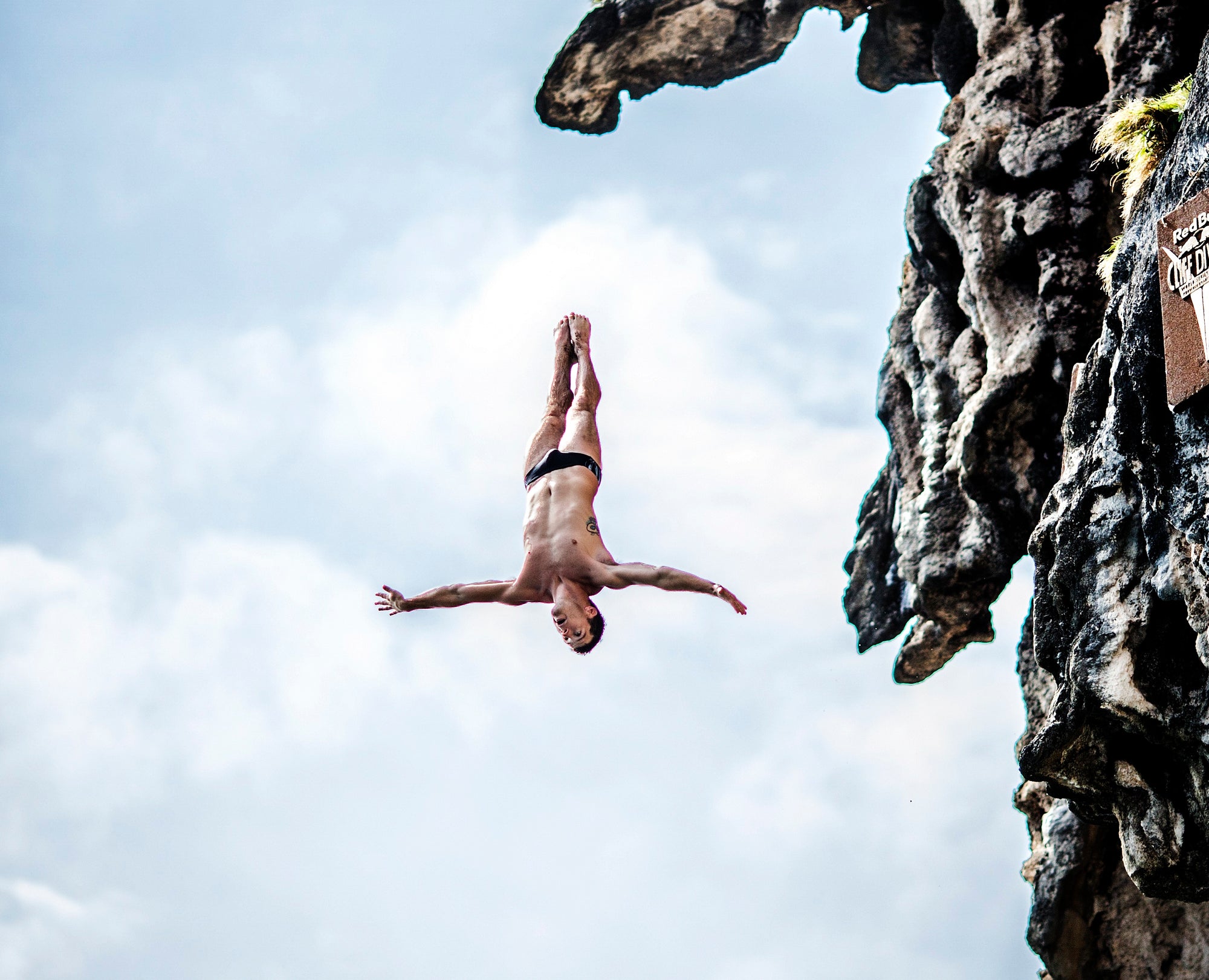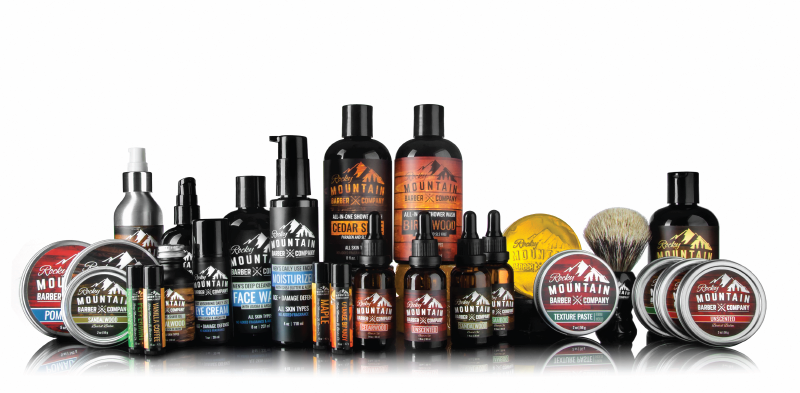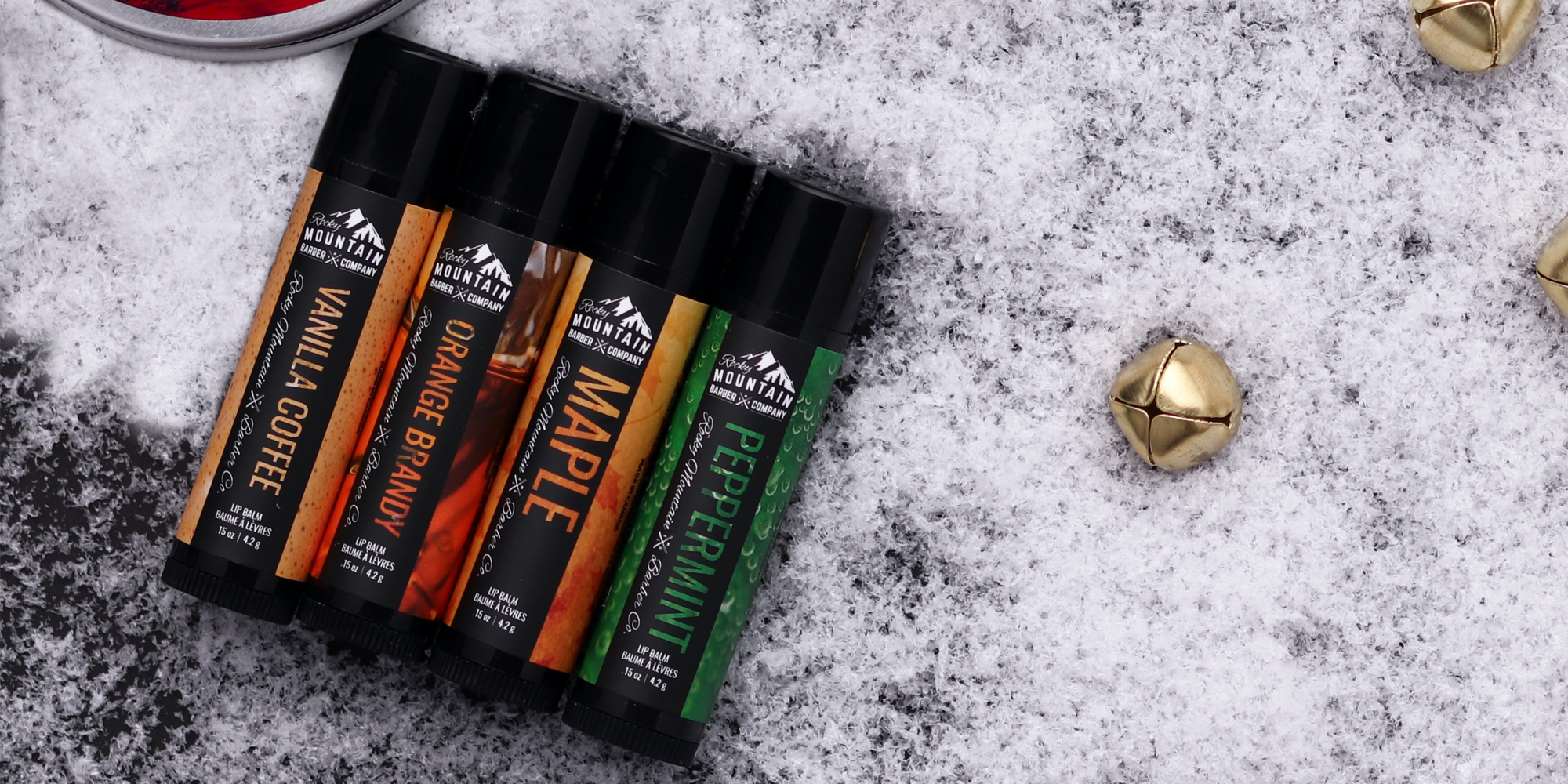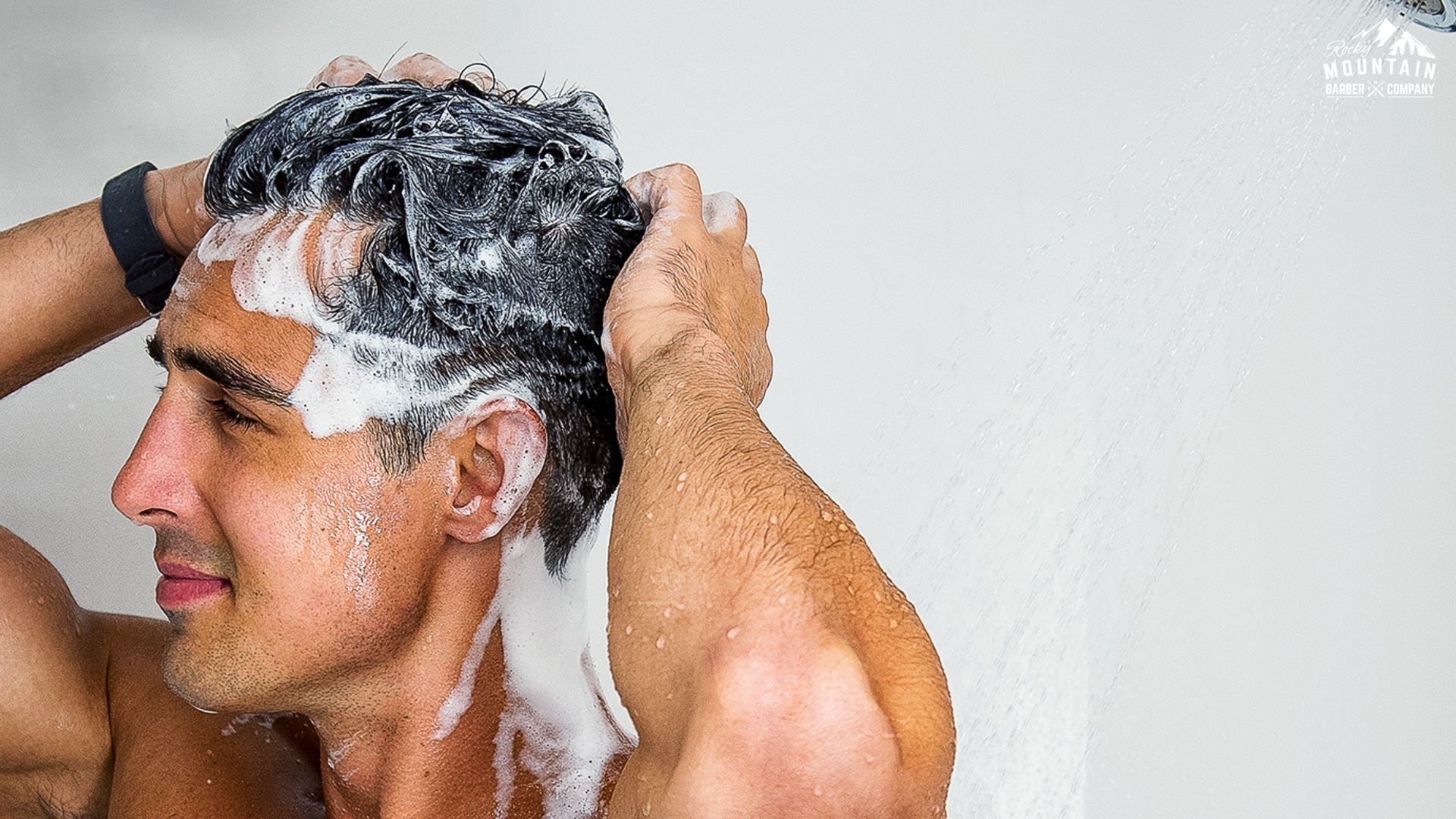
Photo credit: Dean Treml
The high-flying world of competitive cliff-diving is not for the faint of heart. But for veteran Steven LoBue, it's just another day at the office. We sat down with the industry pro to learn just how he does it.
Q: How did you get into the sport of cliff diving?
My journey into the sport of cliff diving started at age seven. I started diving with a local age group diving club and began building the basics and fundamentals of what would be a lifelong passion. By age 11 I was regularly traveling around the country competing with my team, and what had started as a few simple jumps from the side of the pool had turned into multiple flips and twists from the one and three meter springboards. By age 12 I was competing at the national level regularly, and eventually competing from up to 10 meters with my sights set squarely on a college scholarship and the Olympics.
After high school I accepted a scholarship to compete for Purdue University and during my time there honed and sharpened my skills with coaches of the highest caliber. When my competitive career came to an end in 2007, I was at a crossroads of sorts where I was burnt out from competing, but had an undying passion for the sport of diving and a desire to continue using the skills I had spent a lifetime acquiring.

Q: When did you seriously start to consider cliff-diving as a career?
I made the decision to continue my passion by transitioning into the entertainment aspect of diving, which I would come to find is how many competitive cliff divers get their start. Cruise ships, amusement parks and fairs around the country and world produce water based shows with a high diving act, and it’s through these productions that many divers have access for the first time to a platform higher than the standard olympic 10 meter.
Though these “platforms” have a moveable perch so divers can ascend at their own pace, these radio tower like structures are sketchy at best. After climbing straight up 20-27 meters (depending on the show) with no harness, you get to stand on an 11”x11” perch and look down to a pool that looks hysterically small with the knowledge that you could land in the 3rd row of the audience if something went wrong.
After a few stints as a pirate, a frog, a lemur and “the guy who lights himself on fire”, I moved to China in 2009 to pursue diving and high diving as a full-time job. Up until this point I had done high dives from about 20 meters and working in a live-action stunt show I had my first exposure to 27 meters. That same year, Red Bull Cliff Diving had live streamed the final cliff diving event in Italy and as I watched the divers compete, I thought they were totally insane and actually didn’t give it much thought.

Photo credit: Romino Amato
Q. How did you get involved in the Red Bull World Cliff Diving Series?
After a year in China I moved home and as I waited for my next work contract with Royal Caribbean Cruise Lines to start, I got word that Red Bull was hosting a qualifying competition and that they were inviting the top 6 finishers to join the Red Bull Cliff diving World Series for 2011.
After some hesitation and completely void of any expectations, I sent in my video resume and to my surprise was invited to compete at the Qualifier in Australia. However, though I had some high diving experience, I didn’t really have all of the dives required for a competition, which meant I had to learn new dives in practice just days before the competition. That process did not go well. Chalk it up to a combination of nerves and lack of experience but in the process of learning a new dive I over-rotated on entry (too much somersault) fracturing my tailbone and causing an instant feeling of “what the hell did I get myself into?”.
Two days later, I managed to get through the competition with the help of ibuprofen and somehow qualified for the Red Bull Cliff Diving World Series in the final spot by .01 points, the smallest possible margin of separation in diving. After a short celebration and a long flight home from Australia, my next thought was, “Crap, I have to do this again”. That year, I took part in the 2011 Red Bull Cliff Diving World Series and have been a permanent member of the tour every year since.

Photo credit: Romino Amato
Q: You recently won the Red Bull Cliff Diving World Series in Spain over the summer - what did it mean to you to finish first place after winning the same event 3 years prior?
Honestly to win any event is an emotional experience, however, that location in Bilbao, Spain is particularly close to my heart because of my history there and also because the city is so dang beautiful and fun. In 2015 I had pair of last place finishes, had to withdraw from a competition due to hip injury and managed to become the only person in history to hit his head on the platform (the latter of which went viral on YouTube if you’re into that kind of thing)! It was an arduous season to say the least, but at the final in Spain, I remember announcing to everyone that I was going to be a father, and the next day I managed to win the competition despite a year of turmoil. My next win didn’t come until 3 years later at that same location, so to channel all of those old feelings and find success again was a massive confidence booster leading into what would become the most successful season of my career finishing number two in the world.

Photo credit: Dean Treml
Q: Cliff diving has taken you all over the world - what are some of the most memorable places you've been to and dove from?
Travel is hands down the best perk of Cliff Diving. Though we run a pretty tight schedule from arrival to departure (sometimes only 4 days), we try to take every possible opportunity to experience the local culture whether it’s through food, drink, music or activity. Diving at iconic venues like off of the Copenhagen Opera House, off of the Institute of Contemporary Art in Boston, from the Scalinger Castle in Italy or El Morro Castle in Cuba, It’s easy to get hyper-focused on competition and forget to stop and smell the roses every now and again. I feel truly fortunate that we are able to experience so much of what the world has to offer, and with that, here is a list of some of my favorites!
Favorite Dive Spot/Venue: Ik Kil Cenote, Yucatan, Mexico. The Cenote’s natural beauty and mysticism are an absolute treat for your senses. The venue is very small, fitting maybe a few hundred spectators at most, but the fresh water entry surrounded by the circular walls of the Cenote create a diving environment that really is second to none.

Photo credit: Dean Treml
Favorite City: Bilbao, Spain. Located in the Basque region of Spain, Bilbao is a city teeming with history, architecture and of course the best wine and tapas around! Also, the event itself is beautiful and energetic with the Guggenheim Museum as our backdrop and upwards of 45,000 spectators.

Photo credit: Romino Amato
Best Food: Anywhere in Italy because c’mon, it’s Italy!
Toughest Venue: Azores, Portugal. Located in the middle of the Atlantic Ocean, off the Island of Sao Miguel is an old caldera, Villa Franco do Campo. This venue produces some of the most picturesque videos and photos of all time, but at a cost. Before launching from the platform, divers here will perform two dives directly from the cliff face with the added pressures of a smaller landing zone due to underwater shelves. The real challenge, however, is the unpredictability of the ocean. Ocean swells between 2-3 meters can erase thousands of hours of practice in an instant and change the momentum of the contest. It takes skill and a little bit of luck to have success in Portugal!

All Around: Thailand. The 2013 World Series final was held in Thailand and as a group we travelled from Phi Phi Don to Krabi competing 8 dives from 4 different locations. This trip was one of my all time favorite adventures and a surreal combination of culture shock, stunning visuals, and adrenaline overload. At one point we were shuffling across a single piece of bamboo 40 meters above the water just so we could abseil down 13 meters to a flat piece of rock the size of a dinner plate. I remember looking out at the beautiful ocean and natural earth all around and thinking this place was a cliff divers dream. Diving aside, Thailand has so much to offer from hiking, fishing, and scuba diving to beautiful beaches, resorts and a boisterous night life. I can’t wait to go back someday!
 Photo credit: Dean Treml
Photo credit: Dean Treml
Q: Standard Olympic diving height is 10m and cliff diving is anywhere from 26-30+m - what's the biggest differences/adjustments you need to make in terms of how you approach these dives?
The biggest and most notable difference between cliff diving and Olympic diving is obviously the height from which we dive, almost three times the height of Olympic style diving.

Photo credit: Dean Treml
The next thing you’ll probably notice is that all of the cliff divers land on their feet. This is because the impact from 27 meters is too strong for the wrists, elbows, and shoulders to withstand and this is also the biggest physical change for a diver switching from Olympic style diving to cliff diving. Divers need to essentially re-learn how to enter the water feet first, and as with any process it can be tedious and frustrating. Also, I found the need for mental visualization had increased drastically. The hands-down most difficult part of cliff diving is that there are almost no training facilities that allow 27 meters. This means that most divers (who aren’t working an entertainment show) don’t have access to a high dive above 10 meters during the off season, hence the need for increased mental visualization. To put that into context, imagine a Major League Baseball pitcher taking 5 months completely off from throwing a pitch, then being asked to step in and start the world series with 5 or 6 warm ups tosses. Thankfully, as cliff diving/high diving streamlines toward the Olympics, we are starting to see more interest and China just recently built the first ever full high diving facility.

Photo credit: Romino Amato
Q: Are there other outdoor sports or activities you enjoy spending your free time doing?
Definitely! I grew up as an active kid and though I was committed to diving from an early age, I fell in love with skateboarding and snowboarding. I don’t get out to skate as much as I would like to anymore, and South Florida isn’t exactly a snowboarders paradise, but I definitely still love the feel of a board under my feet anytime I can get it. Lately, disc golf has been my main outdoor hobby. It’s a peaceful feeling to be out on the course and it can definitely be incredibly challenging which helps stoke my competitive fire a little bit. The majority of my free time however, is now devoted to my beautiful 3 year old daughter. I’ve been fortunate enough these past two years to call Cliff Diving my full-time job so I’ve been able to take the winter off-season as a stay at home dad to make sure my daughter has as many adventures as possible during these all important early years.
Q: What's your morning routine look like?
Mornings with a 3 year old girl in the house can be tricky and it’s tough to always have a consistent morning routine. I’m a morning bird though so I usually get up between 5:30-6:00am. I drink a glass of water while the coffee is brewing and lay down on the ground for a light wake up stretch/system check, basically just trying to listen to my body so I can address whatever I need to later at the gym and throughout the day. That process can take anywhere from 5 to 25 minutes and is essentially a mindful meditation practice to help clear my mind, be present and prepare for the day. Then it’s one foot up on the counter for a light stretch over a cup of coffee while I take whatever time I have left before my daughter wakes up to scroll through emails, news, social media, and make any lists or notes I need for the day. Once my daughter wakes up usually around 6:45am, it’s all business! Breakfast, play time, walk the dogs, and then off to school. I drop her at 9am and then go directly to the gym to start the daily grind!
Q: What's your favorite Rocky Mountain Barber product?
I have to say I’m really digging the Sweet Orange Deodorant and daily face moisturizer, but I think the Pomade is my must have daily product!
Photo credit: Romino Amato





 Follow Steven on Instagram
Follow Steven on Instagram

